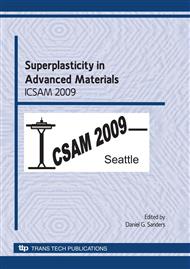p.41
p.49
p.57
p.63
p.69
p.77
p.85
p.93
p.103
High Temperature Fatigue of SPF Die Ni-Cr-Fe Heat Resistant Nickel-Chromium Cast Steels
Abstract:
Superplastic forming of titanium alloy sheets requests long time operating conditions in the range of 900-950°C. Moreover, in a classical press-furnace process environment, die surface temperature drops during sheet unloading and induces high temperature thermo-mechanical fatigue. In order to withstand such extreme conditions in oxidative atmosphere, cast heat resistant nickel chromium steel grades have been developed. The high chromium content (close to 25%) aims to protect against the oxidizing environment, whereas the nickel content is selected with respect to the expected in service loads. The 50% nickel grades are in general used for heating plates, huge casings and cover-plates; whereas 40% nickel grades are selected for inserts and medium size self-standing dies. Cost considerations (Nickel and machining) are also taken into account by the end users for making their choice. An extensive testing program has been performed, in the range of 20 to 950°C, to understand the high temperature fatigue behaviour of these grades and to identify material behaviour models for simulation purposes. This paper presents the major results of these research works and highlights the impact of the nickel content in terms of stress level and life time. Nevertheless, when looking on behaviour, test results show that a unified elasto-visco-plastic cyclic behaviour model is well suited for thermo-mechanical cyclic modelling whatever the grade is. Isothermal identification strategy and out of phase SPF die representative anisothermal fatigue validation are presented.
Info:
Periodical:
Pages:
69-76
Citation:
Online since:
March 2010
Authors:
Price:
Сopyright:
© 2010 Trans Tech Publications Ltd. All Rights Reserved
Share:
Citation:


